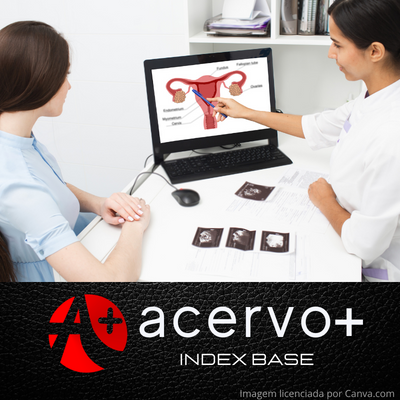Análise das características da Endometriose
##plugins.themes.bootstrap3.article.main##
Resumo
Objetivo: Analisar as características da Endometriose. Revisão bibliográfica: A endometriose é uma doença inflamatória dependente de estrogênio e benigna que afeta 5 a 10% das mulheres em idade reprodutiva. Atualmente, 190 milhões de mulheres em todo o mundo apresentam endometriose. Embora a endometriose seja um processo comum e não maligno, o tecido ectópico semelhante ao endométrio em locais fora do útero e a inflamação resultante podem causar dismenorréia, podendo ocorrer também dor pélvica não cíclica, dispareunia, menorragia, disúria, disquezia dor crônica e infertilidade. Considerações finais: A endometriose representa um problema de saúde a nível mundial por acometer mulheres em idade reprodutiva com dor pélvica crônica, de difícil diagnóstico, que ocasiona custos ao sistema de saúde, perdas laborais e problemas psicológicos grande parte associados à dor e a infertilidade. Seu tratamento pode ser clínico ou cirúrgico e visa o alívio dos sintomas, além de se basear no desejo ou não de concepção. Para o tratamento daquelas que não desejam engravidar a escolha de primeira linha são os anticoncepcionais orais combinados. Já para aquelas que desejam gestar e sofrem com a infertilidade a cirurgia parece uma alternativa viável.
##plugins.themes.bootstrap3.article.details##
Copyright © | Todos os direitos reservados.
A revista detém os direitos autorais exclusivos de publicação deste artigo nos termos da lei 9610/98.
Reprodução parcial
É livre o uso de partes do texto, figuras e questionário do artigo, sendo obrigatória a citação dos autores e revista.
Reprodução total
É expressamente proibida, devendo ser autorizada pela revista.
Referências
2. AMRO B, et al. New Understanding of Diagnosis, Treatment and Prevention of Endometriosis. Int J Environ Res Public Health, 2022; 19(11): 6725.
3. ANASTASIU CV, et al. Biomarkers for the Noninvasive Diagnosis of Endometriosis: State of the Art and Future Perspectives. Int J Mol Sci, 2020; 21(5): 1750.
4. BAFORT C, et al. Laparoscopic surgery for endometriosis. Cochrane Data Rev, 2020; 10(10): 11031.
5. BONAVINA G, TAYLOR HS. Endometriosis-associated infertility: From pathophysiology to tailored treatment. Front Endocrinol (Lausanne), 2022; 13: 1020827.
6. BRICHANT G, et al. New Therapeutics in Endometriosis: A Review of Hormonal, Non-Hormonal, and Non-Coding RNA Treatments. Int J Mol Sci, 2021; 22(19): 10498.
7. BROI MGD, et al. Ethiopathogenic mechanisms of endometriosis-related infertility. JBRA Assist Reprod, 2019; 23(3): 273-280.
8. BULUN SE, et al. Endometriosis. Endocr Rev, 2019; 40(4): 1048-1079.
9. COCCIA ME, et al. Endometriosis and Infertility: A Long-Life Approach to Preserve Reproductive Integrity. Int J Environ Res Public Health, 2022; 19(10): 6162.
10. COLLINNET P, et al. Management of endometriosis: CNGOF/HAS clinical practice guidelines - Short version. J Gynecol Obstet Hum Reprod, 2018; 47(7): 265-274.
11. CORTE DL, et al. The Burden of Endometriosis on Women's Lifespan: A Narrative Overview on Quality of Life and Psychosocial Wellbeing. Int J Environ Res Public Health, 2020; 17(13): 4683.
12. CROMEENS MG, et al. Timing, delays and pathways to diagnosis of endometriosis: a scoping review protocol. BMJ Open, 2021; 11(6): e049390.
13. FILIP L, et al. Endometriosis Associated Infertility: A Critical Review and Analysis on Etiopathogenesis and Therapeutic Approaches. Medicina (Kaunas), 2020; 56(9): 460.
14. FRANÇA PRC, et al. Endometriosis: A Disease with Few Direct Treatment Options. Molecules, 2022; 27(13): 4034.
15. GRUBER TM e MECHSNER S. Pathogenesis of Endometriosis: The Origin of Pain and Subfertility. Cells, 2021; 10(6): 1381.
16. HODGSON RM, et al. Interventions for endometriosis-related infertility: a systematic review and network meta-analysis. Fertil Steril, 2020; 113(2): 374-382.
17. KALAITZOPOULOS DR, et al. Treatment of endometriosis: a review with comparison of 8 guidelines. BMC Womens Health, 2021; 21(1): 397.
18. KAPOOR R, et al. Pathogenesis of Endometriosis: New Insights into Prospective Therapies. Int J Mol Sci, 2021; 22(21): 11700.
19. KIDO A, et al. MRI in the Diagnosis of Endometriosis and Related Diseases. Korean J Radiol, 2022; 23(4): 426-445.
20. KONINCKX PR, et al. Pathogenesis Based Diagnosis and Treatment of Endometriosis. Front Endocrinol (Lausanne), 2021; 12: 745548.
21. LAGANÀ AS, et al. The Pathogenesis of Endometriosis: Molecular and Cell Biology Insights. Int J Mol Sci, 2019; 20(22): 5615.
22. LIN YH, et al. Chronic Niche Inflammation in Endometriosis-Associated Infertility: Current Understanding and Future Therapeutic Strategies. Int J Mol Sci, 2018; 19(8): 2385.
23. PIESSENS S, EDWARDS A. Sonographic Evaluation for Endometriosis in Routine Pelvic Ultrasound. J Minim Invasive Gynecol, 2020; 27(2): 265-266.
24. SACHEDINA A e TODD N. Dysmenorrhea, Endometriosis and Chronic Pelvic Pain in Adolescents. J Clin Res Pediatr Endocrinol, 2020; 12(1): 7-17.
25. SAUNDERS PTK e HORNE AW. Endometriosis: Etiology, pathobiology, and therapeutic prospects. Cell, 2021; 184(11): 2807-2824.
26. SINGH SS, et al. Surgical Outcomes in Patients With Endometriosis: A Systematic Review. J Obstet Gynaecol Can, 2020; 42(7): 881-888.
27. SMOLARZ B, et al. Endometriosis: Epidemiology, Classification, Pathogenesis, Treatment and Genetics (Review of Literature). Int J Mol Sci, 2021; 22(19): 10554.
28. VANNUCCINI S, et al. Hormonal treatments for endometriosis: The endocrine background. Rev Endocr Metab Disord, 2022; 23(3): 333-355.
29. WANG PH, et al. Endometriosis: Part I. Basic concept. Taiwan J Obstet Gynecol, 2022; 61(6): 927-934.

